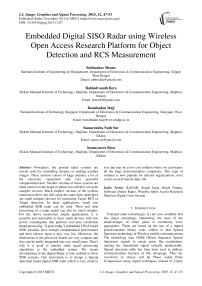Embedded Digital SISO Radar using Wireless Open Access Research Platform for Object Detection and RCS Measurement
Автор: Subhankar Shome, Rabindranath Bera, Bansibadan Maji, Samarendra Nath Sur, Soumyasree Bera
Журнал: International Journal of Image, Graphics and Signal Processing(IJIGSP) @ijigsp
Статья в выпуске: 12 vol.7, 2015 года.
Бесплатный доступ
Nowadays, the ground radar systems are mostly used for controlling airspace or making weather images. These systems consist of large antenna, a lot of the electronic equipment and very powerful computational unit. Smaller versions of these systems are often carried on the board of planes but still they are quite complex devices. Much simpler versions of the systems mentioned above but still using the same basic principles are small compact devices for measuring Target RCS or Target detection. In these applications, small size embedded SDR radar can be used. Then real time processing of a radar signal can also be much simpler. For the above mentioned simple applications, it is possible and reasonable to have small devices with low power consumption that perform real time correlation based processing. Typical today's embedded FPGA based SDR solutions have enough computational performance and their electric input is also very low. Moreover, the dimensions of the processor boards are very compact and they can be easily integrated into very small cases. That's why it is good to transfer radar signal processing algorithms to the embedded system. The recent development in the digital Radar is now molded in these SDR systems. Our motivation is to design a Spread Spectrum based digital SDR radar which is very small in size and may be a low cost solution where we can bypass all the huge instrumentation complexity. This type of solution is now popular for defense organizations, even can be used in human daily life.
RADAR, Single Input Single Output, Software Define Radio, Wireless Open Access Research Platform, Radar Cross Section
Короткий адрес: https://sciup.org/15013935
IDR: 15013935
Текст научной статьи Embedded Digital SISO Radar using Wireless Open Access Research Platform for Object Detection and RCS Measurement
Published Online November 2015 in MECS
Patented radar technologies [1] are now available that has major advantages eliminating the most of the disadvantages of either pulse or continuous wave approaches. Those are based on the use of a digital pseudo-random binary code, similar to that Spread Spectrum technology in Wireless mobile communications. The technology uses DSSS (Direct Sequence Spread Spectrum) signals to create noise like modulation, making the transmitted signal virtually undetectable. Spread spectrum radio has long been used in military communications because of this advantage. Thus the waveform of choice will be Phase coded Pulse Compression using digital techniques instead of Linear
Frequency modulation LFM based analog techniques [2]. Sometimes pulse compression radars have been called spread spectrum radars. The pulse compression nature of this signal processing provides significant protection against normal Interference. Therefore, DSSS radar [3] will be aimed for the development. Scientists and Technologists involved in the development of radar and remote sensing systems all over the world are now trying to involve themselves in saving of manpower in the form of developing a new application of their ideas in embedded integrated Digital radar [4]. Digital or DSSS Radar has been a vibrant scientific field for the last few years [5]. Over the years, digital radar systems have developed considerably, and contemporary advanced radars use Software Define Radio (SDR) based development to minimize the size of Radar which may be useful in human daily life for home security or medical purposes, etc. In software radio, most signal processing is performed by software and reconfigurable digital hardware, so it offered some flexibility that is impossible in traditional radio implementation. Its architecture allows of software programmability to many parameters such as bandwidth, central frequency, modulation and demodulation scheme, coding and decoding schemes, link layer protocol and so on. However, software radio does not imply completely remove the hardware, it means to replace some fixed application specific hardware with flexible and reconfigurable hardware that may be programmed for desired functionality. Since its flexibility and robustness, software radio already been applied in communication, moreover it will be the future develops direction of radio. At the same time this design thought and method also completely suit in the radar design. In our design we have tried to develop DSSS radar using an embedded WARP SDR kit [6], in which polyphase code is used in the radar transmitter to provide the spreading effect, whereas a correlation based receiver is designed in the same SDR kit for the target detection and for Radar Cross section (RCS) measurement. In radar, a target is characterized by its radar cross section (RCS) function [7]. This work is basically extension of previous DSSS Radar development work done at Sikkim Manipal Institute of Technology (SMIT) [8] [9]. There authors had developed a DSSS Radar using Arbitrary Waveform generator as transmitter, RF up and down conversion section designed by RF components and a Digitizer along with vector signal analyzer as receiver but this set up is heavy in size and a combination of several costly equipments. Our efforts convert this huge setup in a single board environment which is a very low cost solution also.
-
II. Warp Sdr Hardware
The Wireless Open-Access Research Platform (WARP) is a scalable and extensible programmable wireless platform, built from the ground up to prototype advanced wireless networks. WARP combines high-performance programmable hardware with an open-source repository of reference designs. The special feature of this hardware is as follows: [10]
-
• Xilinx Virtex-6 LX240T FPGA
-
• 2 programmable RF interfaces, each with:
o 2.4/5GHz transceiver (40MHz RF bandwidth)
o Dual-band PA (20dBm Tx power)
o Shared clocking for MIMO applications
-
• FMC HPC expansion slot
-
• 2 gigabit Ethernet interfaces
-
• DDR3 SO-DIMM slot
-
• FPGA config via JTAG, SD card or flash
-
• User I/O:
o USB-UART o 12 LEDs o 2 seven-segment displays
-
o 4 push buttons
-
o 4-bit DIP switch
• 16-bit 2.5v I/O header [11]
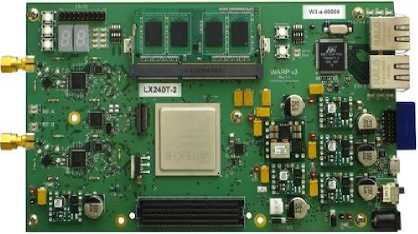
Fig.1. WARD Hardware board with 2 Radio Cards
-
III. Radar Code Generation
Baseband transmitted Signal of the Radar System mainly consists of pulsed PN (P4 code) sequence generation. P4 code used in SS Radar operation gives better SNR at the receiver. The Spreading signal is formed by multiplying a pulse width of 5 usec with Polyphase code having chip rate of 200 ns [= 1/Bandwidth]. SDR board is highly programmable using MATLAB. In first stage authors have concentrated their development to generate P4 code through SDR Board. P4 codes are beneficial in modern radar, having MPSK (Mary Phase Shift Keying) property, and are normally derived from the phase history of Frequency-modulated pulse. P4 codes can be expressed as: [12]
φ i = π (i -1) (i - 1-M)/M, (1)
Whereφi = i th order phase.
M= no of phase states
The values of φi are computed using equation 1 which is generated by Matlab coding. A PC along with Matlab is connected through SDR for hardware realization of the P4 code. The P4 code is generated and communicated over a RF transmitter which is connected with a 2.4 GHz parabolic dish antenna. Another parabolic dish is connected with SDR receiver which is receiving the RF signal and processed through SDR. P4 code is recovered and saved in a file which is plotted in fig 4. Baseband code generation is experimented over communication system set up is shows in fig 2. Generated Baseband code using WARP SDR is shown in fig 3 and recovered baseband IQ P4 in receiver side is shown in fig 4.
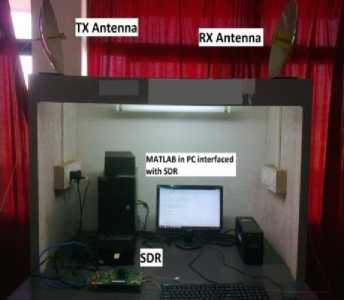
Fig.2. System Setup in Communication Mode.

Fig.3. Generated Baseband code through SDR
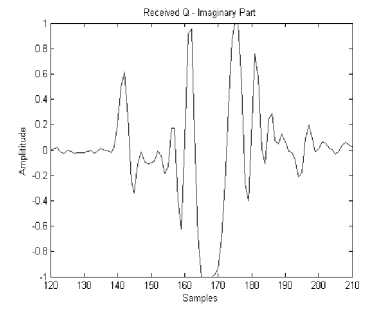
Fig.4. Received I Baseband zoomed Data from SDR board
-
IV. System Bandwidth Selection
By controlling the transmit bits author have achieved 30 MHz bandwidth as shown in figure 5, around 350 samples are transmitted to get desired bandwidth. The high bandwidth signal is advantageous for the Radar experiment. The author have tried the Radar experiment with 5 MHz bandwidth also which is not impressive, so 30 MHz P4 code is transmitted towards the target and after reflecting back the correlation receiver is generating a corellation peak if the code is matched. This receiver is working based on the matched filtering process which is used for 3G mobile communication also. [13]
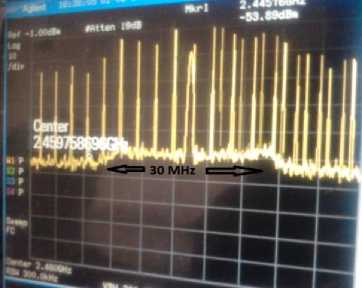
Fig.5. Signal Bandwidth set to 30 MHz
-
V. Siso Radar Experiment
In outdoor experiment [14], Transmit and Receive antenna are placed at outdoor environment. Flat plates are used to place in front of the Radar as target which is located at the opposite side of the Antennas, as our bandwidth is 30MHz the range resolution is calculated to 5mt. That means our Radar are able to identify different targets separately if Targets are separated with minimum 5mt distance from radar as well as from each others. If Target distance is less then 5mt then multiple target peaks will not be resolve separately and it will show multiple targets as single one. Indoor Part of our Radar which is basically the Baseband Part, consisting of SDR Board and the PC in which Matlab is running is shown in figure 6. WARP SDR board is having two radio cards inbuilt with it. One Radio is programmed as Transmitter and another one is kept as receiver.
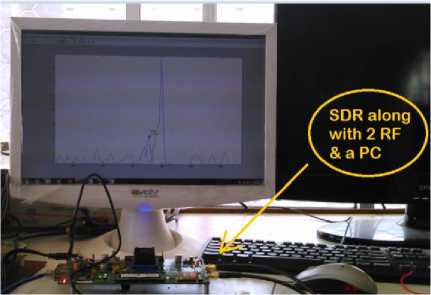
Fig.6. SDR Setup with PC
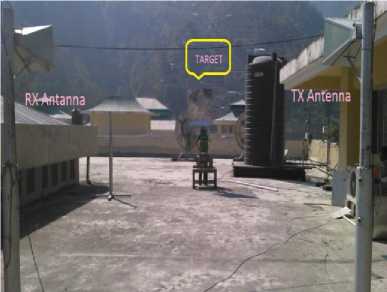
Fig.7. Target Detection Setup
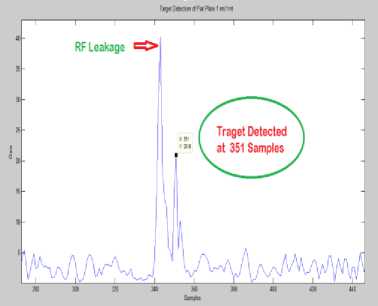
Fig.8. Target Detection of 1mt/1mt Flat Plate
Two horn antennas are connected with the RF cards using environment using those long RF cables which is mainly the RF Part of our experiment, is shown in figure 7. Using above system author has performed Radar experiment. In figure 8 the target detection is shown, peak is generated by the corellation between the transmitted and received signal, received signal is saved in a file using LAN port which is connected between the board and PC. Received RF signal is processed by SDR board and baseband P4 code in receiver side is saved in a file in the connected PC. The file is saved in mat format using Matlab programming. Received code and transmitter reference is corellated and target peak is generated. In this experiment an another peak is also present in the result window which is known as RF leakage, it is generated due to direct leakage of transmitted signal in between two RF cards present in SDR board as both the cards are embedded very nearby in small SDR hardware . Significantly the amplitude of the received signal is improved using corellation gain which is detected at sample number 351.
-
VI. Multi-Target Detection
Список литературы Embedded Digital SISO Radar using Wireless Open Access Research Platform for Object Detection and RCS Measurement
- Skolnik,M.: Radar Handbook, Third Edition, New York, NY, USA, McGraw-Hill, 2008, ISBN 00-71485-47-3.
- Griffiths, H.D.: New ideas in FM radar, Electronics Communication Engineering Journal, vol.2, no.5, pp.185-194, Oct 1990.
- Nilesh Shirude, Manoj Gofane, M.S.Panse, Design and Simulation of RADAR Transmitter and Receiver using Direct Sequence Spread Spectrum, IOSR Journal of Electronics and Communication Engineering e-ISSN: 2278-2834,p- ISSN: 2278-8735.Volume 9, Issue 3, Ver. VI (May - Jun. 2014), PP 56-65.
- M. Skolnik, Introduction to Radar Systems, McGraw-Hill, 3rd ed., 2002.
- Purdy, R. J., Blankenship, P. E., Muehe, Ch. E., Rader, Ch. M., Stern, E., Williamson, R. C.: Radar Signal Processing, Lincoln Laboratory Journal, vol.12, no.2, pp.297-320, 2000.
- Patrick Murphy, Ashu Sabharwal and Behnaam Aazhang," Design of WARP: a wireless open-access research platform" 14th European Signal Processing Conference (EUSIPCO 2006), Florence, Italy, September 4-8, 2006.
- Knott EF, 'Radar Cross Section ', second edition, Scitech publishing, Raleigh, NC, 2004.
- Rabindranath Bera, Sourav Dhar, Debdatta Kandar, "Digital Radar for Collision Avoidance and Automatic Cruise Control in Transportation".
- Soumyasree Bera, Arun Kumar Singh, Samarendra Nath Sur, Debasish Bhaskar, Rabindranath Bera "Improvement In Target Detectability Using Spread Spectrum Radar In Dispersive Channel Condition" International Symposium on Electronic System Design, 2012.
- Http://warpproject.org/trac/wiki/about
- Http://warpproject.org/trac/wiki/HardwareUsersGuides/WARPv3.
- Carroll J. Nunn, Gregory E. Coxson, "Polyphase Pulse Compression Codes with Optimal Peak and Integrated Sidelobes", Technology Service Corporation Suite 800, 962 Wayne Avenue, Silver Spring, Maryland 20910.
- Amit Agarwal, Samarendranath Sur, Soumyasree Bera, Rabindranath Bera, "Bandwidth Exploration in Radar System for Target Resolution" Advances in Intelligent Transportation Systems (AITS) 46 Vol. 1, No. 2, 2012, ISSN 2167-6399.
- Rabindranath Bera, Jitendranath Bera, Sanjib Sil, Sourav Dhar, Debdatta Kandar, Dipak Mondal, "RADAR Imaging in the Open field At 300 MHz-3000 MHz Radio Band" Sikkim Manipal Institute of Technology, Sikkim Manipal University, Majitar, Rangpo, East Sikkim 737132, India.
- Samarendra Nath Sur, Soumyasree Bera, Rabindranath Bera, "Adaptive CLEAN Algorithm for High Resolution Inverse synthetic aperture radar (ISAR) Imaging for Vehicular Application" 9th International Radar Symposium India - 2013 (IRSI - 13).

